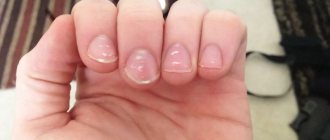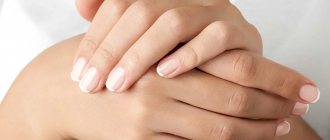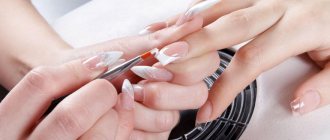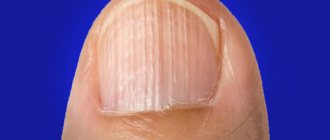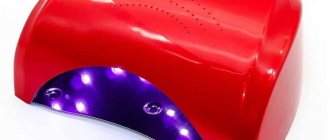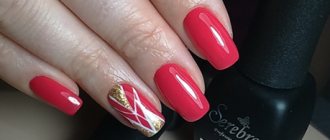Every woman wants to look attractive and charming, and for this she needs to constantly take care of herself. Care is needed for the body, face, hair and hands; special attention must be paid to nails, because beautiful well-groomed hands and nails indicate the health of a woman or girl. More and more often, girls are resorting to such a procedure as nail extensions; it is very popular, and most importantly – very beautiful. But it happens that nails begin to peel off almost immediately. It is important to know what the reasons are and how to avoid it and what to do if your nail extensions peel off. Let's look at these issues in more detail, and also consider some reviews from girls regarding this issue.
Gel extensions - what kind of procedure is it?
Gel is a plastic material that is easy to work with. It allows you to do nail extensions both at home and in a beauty salon. As a result of the master’s work, the length of the nails increases, their shape changes, and the surface is smoothed.
Gel nail extensions
Gel extensions last up to 4 weeks ; the structure of this polymer resembles natural nails , and it looks much more natural than acrylic.
There are two methods of extension using gel. The first is a sticker of ready-made artificial plates (tips), and the second is an extension in shape.
This method requires durable stencils that are applied to the nails, and the gel is applied through the “window”. After the gel has completely hardened, the forms are removed, and the result is beautiful nails with a length longer than natural.
How to avoid cracking gel polish?
Cracking of the coating (either gel or gel polish) can be avoided if you adhere to a few basic rules:
- use proven materials for the extension procedure (read on forums and review sites to purchase a more or less “proven” product);
- A long-lasting manicure can be obtained only after following the application technology with all stages: polishing, dehydration, degreasing, base, color, top;
- The preparation of the plate should be carried out carefully, removing all delaminations and damage with a buff. If necessary, strengthen your nails in advance with bio-gel or acrylic;
- It is best to remove gel polish from natural nails by soaking the coating to minimize damage to the nail. When cutting off gel polish with a router, carefully remove only the colored layer, leaving the base untouched.
Popular vloggers will not be able to explain all the nuances of coating nails with gel polish. Therefore, you should not rely only on their advice and expect super results. As they say: “Everything comes with experience.” But each time it is better to draw conclusions so as not to repeat previous mistakes.
Secrets of quality extensions
Despite the apparent simplicity of the procedure, the effect of extensions is not always ideal. But usually any problems (gel detachment, chipping or dullness of the coating) are associated with non-compliance with technology and ignoring simple rules. To obtain high-quality artificial nails, you need to follow these tips:
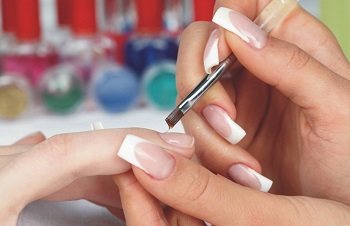
Nail extension process
- If necessary, a trimmed manicure should be done 2 days before extensions or one day after the procedure. Even minor damage should be avoided on the cuticle.
- hand creams a day before extensions, since some components tend to be released from the skin in the future. For this reason, the gel can peel off.
- Taking antibiotics and hormones does not go well with the procedure, and it is better to postpone it.
- Gel extensions cannot be done on sick nails .
There are diseases in which gel detachment and other nail problems are not uncommon. These include diabetes mellitus, heart and vascular diseases, hormonal imbalances, herpes, Graves' disease.
Care and prevention
When treating onychorrhexis, as well as for its prevention in the future, it is important to properly care for the nails, skin of the hands and feet.
What rules must be followed?
- Wash dishes and use any cleaning agents or detergents only with gloves.
- For manicure, choose high-quality varnishes with a harmless composition; do not use removers containing acetone to remove nail polish.
- Avoid frequent contact with water.
- When treating onychorrhexis, it is not recommended to do a manicure or apply any coatings to the nails other than those prescribed by the doctor. In the future, take breaks from wearing gel polish and artificial nails.
- Take care of your drinking regime and a nutritious diet, including fruits, vegetables, and low-fat protein foods.
- Do not grow your nails too long; periodically get medical manicures and pedicures at podiatry centers.
- Massage your hands and feet daily, moisturize the skin on your arms and legs with nourishing creams.
As a rule, onychorrhexis does not cause pain or inflammation, but you still need to go to a podiatrist with this problem. The specialist will prescribe the correct treatment, which will speed up the recovery of the nail and prevent the development of complications. He will also tell you about the rules of care at home so that splitting or splitting of nails no longer bothers you.
13 1
Why do extended nails peel off: internal reasons
Detachment of the gel often occurs with hyperhidrosis of the hands , when sweating is very high. In some women, due to the hormonal characteristics of the body, the gel simply does not stick to the nail plate and is rejected. In addition to pregnancy, menstruation, and post-abortion conditions, the procedure should not be performed during lactation, again due to hormones.
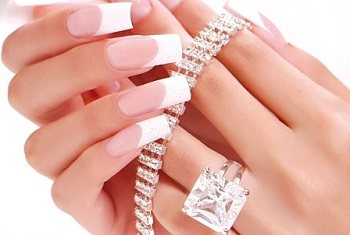
Extensions should be done on healthy nails
If there is an elevated body temperature, an infectious disease , or a severe decrease in immunity, the extension session may also be useless: rapid detachment of the material will occur.
Poor health of natural nails can also be to blame for gel peeling. For example, too thin nail plates, flexible, movable bases cannot hold the material well. A too lumpy, cracked nail surface will also not allow for high-quality extensions. And, of course, fungal diseases of the nail plate are a direct contraindication for extensions.
How to treat?
To treat onychorrhexis, an integrated approach is used, aimed at eliminating the cause, normalizing metabolic processes, and strengthening the structure of the nails. If these conditions are met, treatment gives a good result. True, it takes up to six months, since the nail plate grows slowly, on average by 1 mm per week. The matrix where nails are formed is hidden under the skin of the lower roller, at a distance of 4 mm from the cuticle. It will take 4 weeks just to improve his condition, and to change the plate on his fingers it will take 4 to 6 months.
Treatment is selected depending on the severity of the injuries and the person’s health status. When identifying concomitant pathologies that cause longitudinal clefting, attention is paid to their treatment.
To strengthen nails the following is prescribed:
- massage;
- vitamins, amino acids, minerals;
- medicinal baths;
- drugs to strengthen the walls of blood vessels and improve blood circulation in the extremities;
- physiotherapy (paraffin therapy, ozokerite, mud masks).
Traditional methods and remedies for the treatment of onychorrhexis of nails include masks or baths with natural oils, oil solutions of vitamins, gelatin, as well as moisturizing and nourishing creams. They help strengthen nails and accelerate regeneration processes. But it is better to discuss the safety of their use with your doctor.
In case of deep, long cracks, the plate is reinforced with artificial materials to stabilize it.
Poor quality materials are the cause of gel peeling
The most common cause of the problem is the use of low-quality material . The result is fragile, thin, transparent nails that crack and chip.
Many craftsmen complain that after using the topcoat, the gel begins to crack. The reason is the use of low-quality coating, or its components conflict with the base material. It is better to use all products from the same brand so that there is no difference in the elasticity of the finish and the sculptural layer.
Body condition
However, the reason why extended nails peel off may also lie in the individual characteristics of the body or natural nails. A woman’s hormonal background has a significant impact on the stability of extended nails. During periods of hormonal surge, the material can be intensively rejected as foreign. In this case, even a qualified and highly professional master will not guarantee the stability of the manicure if the nails were extended during:
- Taking hormonal drugs;
- Pregnancy;
- Breastfeeding;
- Menses.
The general condition of the body can be the reason why gel nails peel off. So, this often happens in those who suffer from some chronic disease, as well as in those who performed extensions during the period of an infectious disease. Taking antibiotics and certain medications can also lead to the destruction of manicure. Another reason may be severe sweating of the hands, that is, when the nails are in constant high humidity.
This fact is also influenced by the characteristics of natural nails. A very thin natural nail plate, the presence of fungal and other diseases at a stage when it is still invisible to the master, a movable base of the nail, flexible nails - all this can be the reason why extended nails fall off. In addition, it has been noted that manicure does not last well if false artificial nails have recently been removed.
Gel detachment due to violation of extension technology
Common Causes of Gel Peeling
Lack of experience and the necessary tools, choice of poor material are good reasons for the low quality of artificial nails.
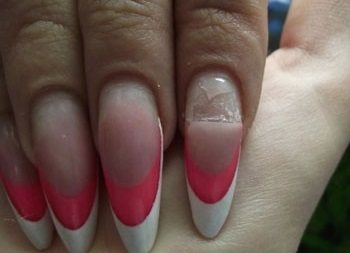
Peeled nail extensions
Peeling often occurs in those who do their own nails - due to carelessness and inconvenience in applying the material.
Even experienced professionals may try to save time by skipping some steps of the procedure, which leads to chipping and peeling of the gel. It is better to visit a trusted specialist or learn how to do quality extensions at home.
Technical reasons for peeling nails
- Incorrect nail modeling,
- applying the finishing coat in a thick layer,
- air bubbles getting under the material,
- poor nail preparation, insufficient polishing,
- the presence of particles of old coating in the cuticle area,
- lack of antibacterial treatment of nail plates,
- the master did not create a stiffener, forgot about the primer, bond, degreaser,
- the gel was applied to a non-dried surface.

Compliance with all extension technologies is the key to flawless extended nails
Compliance with nail extension technology is an important factor in avoiding manicure delamination. Watch the video master class on gel nail extensions from a professional master:
Mistakes when modeling nails: peeling
For the first three years of my practice, I was constantly tormented by this problem; at first, my nails peeled off at the cuticle. I began to clean the pterygium more thoroughly, prepare the nail for extensions, and model the material finely. The cuticle peelings were gone, but half of the clients still had thin strips of peeling material on the sides. Moreover, everything was always fine with the other half. I began to pay attention to the hands of those clients who had detachments and it turned out that they all had pronounced deep side ridges. It turns out that such hands have much more pterygium and their preparation requires more careful processing. The material itself must not only be thin, but must be modeled at a small distance from the skin. For me, it always came into contact precisely in the lateral sinuses.
For clients with a normal nail plate, this did not affect the material in any way, but for those with pronounced lateral sinuses or a tendency to sweat their hands/nails, detachments immediately appeared. This is how I managed to defeat them once and for all.
Therefore, I decided to share with you an overview of the most common problems when modeling nails, what mistakes lead to them and, of course, how to avoid them.
When modeling, you can make many different mistakes that lead to consequences such as breaks, chips, material delamination, and others. Often craftsmen are guilty of low-quality material or an incorrectly selected primer, while in most cases the error lies precisely in the modeling technology. We will look at five of the most common problems. Today we’ll talk about the most popular of them – detachments.
Detachment or delamination of the material is a violation of the tightness of the artificial coating, in which the adhesion of the material to the natural nail plate is disrupted.
Causes:
- The prerigium is not completely cleaned when preparing the natural nail;
- Before the modeling procedure, a manicure procedure was carried out using a cuticle softener and the particles remained on the skin;
- After preparing the nail, the master or client touched the surface of the nail plate, thereby leaving moisture and oils on the nail;
- The material at the cuticle and along the sides was placed too close to the skin;
- The cuticle material was not thin enough; there was a small step between the natural nail and the gel/acrylic;
- When working with acrylic, the consistency was too runny/dry;
- When working with the gel, old UV lamps were used, which do not dry the material completely.
Solution:
When preparing a natural nail, carefully push back the cuticle and make sure that the pterygium is completely removed not only along the cuticle, but also along the lateral sinuses of the nail. After you have removed the gloss from the nail plate, explain to the client that he is now prohibited from touching the surface until the procedure is completed. Some clients like to sit with their cheeks propped up, and there may be powder or foundation applied there, keep an eye on that too. The surface of the nail must be practically sterile before applying the material.
When modeling with acrylic, the balls should not be too wet and spread over the entire nail; this can also affect the strength of the coating and the appearance of air bubbles.
Make sure that the material at the cuticle and along the side ridges is reduced to nothing. If you run your fingernail across the surface, you should not feel the slightest step.
This is what the material should look like in the area of the cuticle and side ridges, so that after 4-5 weeks peeling does not appear on it:
If you cannot model the material thinly at the cuticle, achieve this with the help of a gash.
Have you ever encountered detachments and how did you correct them? Share your experience.
Why does the gel peel off at the base and tips of the nails?
At the base and free edge of the nail plate, peeling of the material occurs most often. This is due to many reasons, here are the main ones:

Manicure peeling at the base of the nail
- During grinding, small areas near the cuticle may remain greasy and untreated. This will cause the material at the base of the nail to tear away. In this case, experienced craftsmen remember the natural curves and use special buffs.
- After a trimmed manicure, areas of cuticle remain . It is better to do a hardware or other non-edged manicure before extensions. If there are pieces of skin, the specialist must remove the keratinization using the device’s attachment.
- The woman touched her nails too early, or hair, clothing, or dust got on them . Such phenomena must be excluded.
- Extended nails were affected by temperature changes . This causes peeling of the gel at the tips of the nail plates, as well as impact and mechanical damage.
Exploitation

Often, rapid deterioration of the quality of a manicure is the fault of its owner. Do not assume that extended or strengthened nails become indestructible. You need to take care of them no less than natural plates, if not more, since due to their large length they are subject to greater loads. The following operating errors can cause gel nail polish to crack:
- Exposing the plates to high temperature and high humidity. In this sense, the sauna is completely destructive for extended or strengthened nails. A heated solarium also causes significant harm, but not so much due to the fact that there is no humidity;
- Water generally has a rather negative effect on the quality of manicure. If you work as a doctor, florist, or in other areas where you have to wash your hands frequently, then you can’t hope that your manicure will last as long as those of those who don’t subject it to such stress;
- One of the most important reasons why gel polish on natural plates cracks is mechanical stress. Its plate is flexible and quite soft, and therefore it can bend even with minimal load. Sometimes it is difficult for the gel layer to withstand such a load and it chips;
- Low temperatures also have a negative effect on the gel. Thus, if you have extended your nails in winter, it is recommended to wear gloves or mittens at all times. Sub-zero temperatures can cause not only cracking, but also tarnishing, chipping and detachment of the gel, both from extended and natural nails.
- Any cleaning products, even not too aggressive ones, destroy the gel on the nails. Cleaning, washing and washing dishes should only be done with gloves.
Following these simple rules can extend the life of your manicure for a long time. If the question of why gel polish peels off nevertheless arises, then you can be sure that the answer to it must be sought in another area.
How to maintain extended nails
To prevent gel rejection, it is important to strictly follow the extension technology. There are a few more rules that will help you avoid troubles and premature correction:
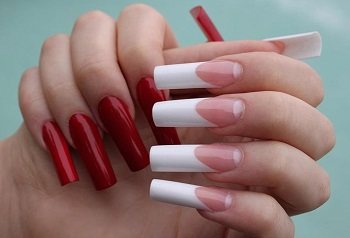
Beautiful extended nails
- After applying the primer, do not touch objects with your nails, and do not touch the nails themselves with your hands.
- File the nail plates only with a soft file.
- Wait enough time after the manicure, do not overuse trimmed manicure.
- Use only high-quality materials.
- Before extensions, do not do paraffin therapy or seal the nails.
- Follow the rules for caring for artificial nails.
Ways to solve the problem
The right solution to prevent manicure deformation is proper care. Do not forget that before the procedure, manicure should not be done for about four days.
After the extension procedure has been carried out, you should not engage in self-correction; a timely visit to the specialist for this work is mandatory. Do not ignore the recommendations of the salon employee who performed the work. Proper care and following the master's recommendations are the key to ensuring that your manicure will last a long time.
Nutritional deficiencies
One of the reasons why nails peel and break is considered to be a deficiency of vitamins, macro- and microelements, and nutrients involved in their formation or directly included in the structure of the plate. The lack of these components causes excessive dieting, an unbalanced diet, and impaired digestion or absorption of nutrients in the gastrointestinal tract.
What nutrients are needed to keep nails strong?
Calcium, phosphorus, silicon, iron. There are many of these minerals in cottage cheese, kefir, fish, apples, cabbage, and nuts. But if the listed products are rare guests on your table, it is possible that this is the reason for the fragility.
With iron deficiency, nails become deformed, dull, and become concave or depressed. The microelement is involved in the synthesis of hemoglobin, the delivery of oxygen to the matrix where the cells of the nail plate are born.
Low calcium levels, in addition to brittle nails, lead to peeling skin, dry hair, and muscle cramps.
The most important vitamins are:
- Biotin (B7). Participates in the formation of the keratin base of the nail;
- Retinol (A). Responsible for the strength, smoothness, elasticity of the plate, the health of the skin around the nail;
- Calciferol (D). Necessary for proper absorption of calcium, which is responsible for the strength of nails;
- Ascorbic acid (C). Strengthens and accelerates nail growth;
- Tocopherol (E). Stimulates the production of collagens and elastins that make up the plate.
Fragility and deterioration of the plate sometimes indicate a lack of protein. Foods high in protein are necessary to nourish nails and synthesize their main structural element - keratin.
Tags
health of nails Shapes of nails on nails designs on nails for nails for nails by Extension Nail extensions Nail extensions with gel nails with gel gel nails Extensions with gel nails peeling off gel peeling off gel Why gel peels off with gel nails nails with gel Gel extension Varnishes Types of varnishes for Varnishes for the use of varnishes for Varnishes Types of varnishes for Varnishes for the use of varnishes for decorative varnishes for decorative varnishes for
designbeautypedicuresliderphoto

